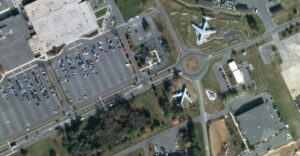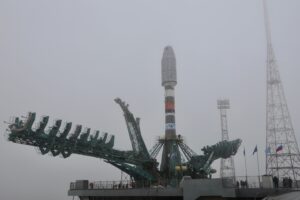Albedo announces $48 million Series A funding round
Wednesday, 07 September 2022 12:00
Earth observation startup Albedo raised $48 million in a Series A funding round.
The post Albedo announces $48 million Series A funding round appeared first on SpaceNews.
KMI wins three Space Force study contracts for debris cleanup technology
Wednesday, 07 September 2022 11:00
Kall Morris Inc. announced Sept. 7 it received three study contracts for debris-remediation technologies under the Space Force’s Orbital Prime program.
The post KMI wins three Space Force study contracts for debris cleanup technology appeared first on SpaceNews.
ESA–EGU Excellence Award 2023 open for nominations
Wednesday, 07 September 2022 11:00
Following the success of the inaugural ESA–EGU Earth Observation Excellence Award in 2021, it’s now time to lodge your nomination for someone or for a team that deserves recognition for their innovative use of Earth observation. The call for nomination opens today and will close on 7 December.
The award winners will be announced and presented at the European Geosciences Union (EGU) General Assembly, which takes place on 23–28 April 2023.
OneWeb takes $229 million charge for canceled Soyuz launches
Wednesday, 07 September 2022 10:35
OneWeb took a $229 million charge this year linked to the termination of its Soyuz launch contract and dozens of satellites stranded in Kazakhstan after Russia’s invasion of Ukraine.
The post OneWeb takes $229 million charge for canceled Soyuz launches appeared first on SpaceNews.
Rocket Lab signs with USTRANSCOM to explore using Neutron and Electron tp deliver cargo worldwide
Wednesday, 07 September 2022 09:12 Rocket Lab USA, Inc. (Nasdaq: RKLB) ("Rocket Lab" or "the Company"), a global leader in launch services and space systems, has announced that it has signed a Cooperative Research and Development Agreement (CRADA) with the United States Transportation Command (USTRANSCOM) to explore the possibility of using the Company's Neutron and Electron launch vehicles to transport cargo around the world. Th
Rocket Lab USA, Inc. (Nasdaq: RKLB) ("Rocket Lab" or "the Company"), a global leader in launch services and space systems, has announced that it has signed a Cooperative Research and Development Agreement (CRADA) with the United States Transportation Command (USTRANSCOM) to explore the possibility of using the Company's Neutron and Electron launch vehicles to transport cargo around the world. Th Gamma rays from neighboring galaxy related to millisecond pulsars
Wednesday, 07 September 2022 09:12 A team of researchers, including UvA physicists and astronomers, has studied gamma rays caused by the Sagittarius Dwarf, a small neighbouring galaxy of our Milky Way. They showed that all the observed gamma radiation can be explained by millisecond pulsars, and can therefore not be interpreted as a smoking gun signature for the presence of dark matter. The results were published in Nature Astron
A team of researchers, including UvA physicists and astronomers, has studied gamma rays caused by the Sagittarius Dwarf, a small neighbouring galaxy of our Milky Way. They showed that all the observed gamma radiation can be explained by millisecond pulsars, and can therefore not be interpreted as a smoking gun signature for the presence of dark matter. The results were published in Nature Astron Antenna enables advanced satellite communications testing
Wednesday, 07 September 2022 09:12 On the rooftop of an MIT Lincoln Laboratory building sits a 38-foot-wide dome-shaped radio antenna enclosure, or radome. Inside the climate-controlled environment, shielded from the New England weather, a steel structure supports a 20,000-pound, 20-foot diameter satellite communications (SATCOM) antenna. The antenna - called the Multi-Band Test Terminal (MBTT) - can rotate 15 degrees per second,
On the rooftop of an MIT Lincoln Laboratory building sits a 38-foot-wide dome-shaped radio antenna enclosure, or radome. Inside the climate-controlled environment, shielded from the New England weather, a steel structure supports a 20,000-pound, 20-foot diameter satellite communications (SATCOM) antenna. The antenna - called the Multi-Band Test Terminal (MBTT) - can rotate 15 degrees per second, Back in Bordeaux with the A310 ZERO G
Wednesday, 07 September 2022 09:12 The 39th parabolic flight campaign of the German Space Agency at the German Aerospace Center (Deutsches Zentrum fur Luft- und Raumfahrt; DLR) is taking place in Bordeaux for the first time in two years, from 29 August to 8 September 2022.
"We're delighted to be returning to the 'old home' of DLR parabolic flights after four campaigns that took place from the airport in Paderborn due to the
The 39th parabolic flight campaign of the German Space Agency at the German Aerospace Center (Deutsches Zentrum fur Luft- und Raumfahrt; DLR) is taking place in Bordeaux for the first time in two years, from 29 August to 8 September 2022.
"We're delighted to be returning to the 'old home' of DLR parabolic flights after four campaigns that took place from the airport in Paderborn due to the RIT scientists to study molecular makeup of planetary nebulae using radio telescopes
Wednesday, 07 September 2022 09:12 By using radio telescopes to study sun-like stars in their death throes, scientists hope to reveal important information about the origin of life-enabling chemicals in the universe. The National Science Foundation is awarding a $339,362 Astronomy and Astrophysics Research Grant to a team led by Rochester Institute of Technology Professor Joel Kastner to conduct such a study.
Planetary nebu
By using radio telescopes to study sun-like stars in their death throes, scientists hope to reveal important information about the origin of life-enabling chemicals in the universe. The National Science Foundation is awarding a $339,362 Astronomy and Astrophysics Research Grant to a team led by Rochester Institute of Technology Professor Joel Kastner to conduct such a study.
Planetary nebu Magnetic skyrmions - ready for take-off?
Wednesday, 07 September 2022 09:12 Magnetic skyrmions are extremely small and stable swirls of magnetization, often referred to as 'topological quasi-particles' since an emerging stability embraces this spin ensemble. As such, skyrmions can be manipulated while retaining their shape. In ferromagnetic thin films, they can conveniently be created with an electrical current pulse or, even faster, with a laser pulse ? albeit, so far,
Magnetic skyrmions are extremely small and stable swirls of magnetization, often referred to as 'topological quasi-particles' since an emerging stability embraces this spin ensemble. As such, skyrmions can be manipulated while retaining their shape. In ferromagnetic thin films, they can conveniently be created with an electrical current pulse or, even faster, with a laser pulse ? albeit, so far, Astronomers show massive stars can steal Jupiter-sized planets
Wednesday, 07 September 2022 09:12 Jupiter-sized planets can be stolen or captured by massive stars in the densely populated stellar nurseries where most stars are born, a new study has found.
Researchers from the University of Sheffield have proposed a novel explanation for the recently discovered B-star Exoplanet Abundance STudy (BEAST) planets. These are Jupiter-like planets at large distances (hundreds of times the dist
Jupiter-sized planets can be stolen or captured by massive stars in the densely populated stellar nurseries where most stars are born, a new study has found.
Researchers from the University of Sheffield have proposed a novel explanation for the recently discovered B-star Exoplanet Abundance STudy (BEAST) planets. These are Jupiter-like planets at large distances (hundreds of times the dist Far-infrared detector KID reaches highest possible sensitivity
Wednesday, 07 September 2022 09:12 Compared to most other wavelengths, astronomy has a blind spot in the area of far-infrared radiation. A far-infrared space telescope can only utilize its full sensitivity with an actively cooled mirror below 4 Kelvin (-269 C). Such a telescope doesn't exist yet, which is why there has been little worldwide investment in the development of corresponding detectors.
In 2004, SRON decided to b
Compared to most other wavelengths, astronomy has a blind spot in the area of far-infrared radiation. A far-infrared space telescope can only utilize its full sensitivity with an actively cooled mirror below 4 Kelvin (-269 C). Such a telescope doesn't exist yet, which is why there has been little worldwide investment in the development of corresponding detectors.
In 2004, SRON decided to b ALMA witnesses deadly star-slinging tug-of-war between merging galaxies
Wednesday, 07 September 2022 09:12 While observing a newly-dormant galaxy using the Atacama Large Millimeter/submillimeter Array (ALMA) and the Hubble Space Telescope (HST), scientists discovered that it had stopped forming stars not because it had used up all of its gas but because most of its star-forming fuel had been thrown out of the system as it merged with another galaxy. The result is a first for ALMA scientists. What's m
While observing a newly-dormant galaxy using the Atacama Large Millimeter/submillimeter Array (ALMA) and the Hubble Space Telescope (HST), scientists discovered that it had stopped forming stars not because it had used up all of its gas but because most of its star-forming fuel had been thrown out of the system as it merged with another galaxy. The result is a first for ALMA scientists. What's m Teams continue to review options for next Artemis I launch attempt
Wednesday, 07 September 2022 09:12 After standing down on Saturday's Artemis I launch attempt when engineers could not overcome a hydrogen leak in a quick disconnect, an interface between the liquid hydrogen fuel feed line and the Space Launch System (SLS) rocket, mission managers met and decided they will forego additional launch attempts in early September.
Over the next several days, teams will establish access to the ar
After standing down on Saturday's Artemis I launch attempt when engineers could not overcome a hydrogen leak in a quick disconnect, an interface between the liquid hydrogen fuel feed line and the Space Launch System (SLS) rocket, mission managers met and decided they will forego additional launch attempts in early September.
Over the next several days, teams will establish access to the ar Massive stars' blasts hitting Orion's sword mapped in unprecedented detail
Wednesday, 07 September 2022 09:12 Astronomers using W. M. Keck Observatory on Hawaii Island have captured from Maunakea the most detailed and complete images ever taken of the zone where the famed constellation of Orion gets zapped with ultraviolet (UV) radiation from massive young stars.
This irradiated neutral zone, called a Photo-Dissociation Region (PDR), is located in the Orion Bar within the Orion Nebula, an active s
Astronomers using W. M. Keck Observatory on Hawaii Island have captured from Maunakea the most detailed and complete images ever taken of the zone where the famed constellation of Orion gets zapped with ultraviolet (UV) radiation from massive young stars.
This irradiated neutral zone, called a Photo-Dissociation Region (PDR), is located in the Orion Bar within the Orion Nebula, an active s 
